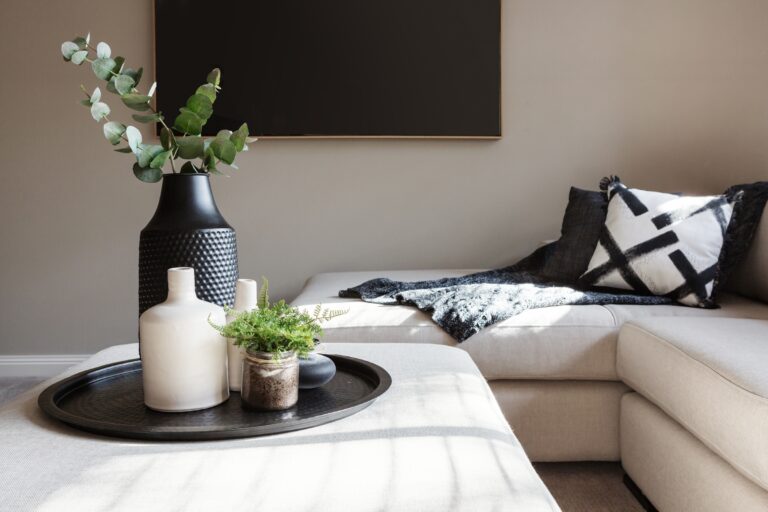Consulting is one of the most versatile tools in an interior designer’s toolkit. It lets you share your expertise without managing a full project, and it can serve many purposes—whether you’re expanding your services, reaching a new audience, or transitioning into a more flexible way of working. But what does interior design consulting actually look like in practice?
In short, consultants step away from detailed floor plans and hands-on project management to offer strategic, high-impact guidance. Instead of overseeing full-scale renovations, they help clients who feel stuck mid-project or just need expert reassurance on a few key decisions.
Let’s take a closer look at interior design consulting, what it entails, and the most common services interior designers provide through consulting.
Table of Contents
What does an interior design consultant do?
An interior design consultant provides expert advice and strategic guidance on design-related challenges, without necessarily being involved in the execution.
A consultant may be brought in for:
- A one-time brainstorming session
- Ongoing strategy during a renovation
- Quick input on a specific design dilemma
The goal of consulting is to deliver value through expertise and insight rather than labor or products. This makes it ideal for designers looking to work on their own terms or serve clients with smaller budgets.
How do consultants differ from interior designers?
To put things simply, a consultant advises, while interior designers create concrete plans (and often also implement those plans). For example, a consultant might help a client choose paint colors or suggest arrangements for decor items, but they won’t necessarily create floor plans or order furniture.
Of course, there’s lots of overlap and many interior designers offer consulting services as part of their business model. Consulting services are particularly attractive to clients who don’t want to pay for a full design project, but want a little help.
Common interior design consulting services
Interior design consulting can take many forms depending on your skillset, niche, and ideal client. Here are some of the most popular types of interior design consulting services.
Space planning
Clients often need professional help improving flow and functionality in their space, making space planning a popular consulting service.
You might:
- Suggest furniture arrangements that balance aesthetics and usability
- Offer recommendations for functional zoning (e.g., work, play, relaxation areas)
- Improve traffic flow and circulation throughout the space
- Provide tips for small-space optimization and multifunctional layouts
This service is especially helpful for clients who are working through life transitions, such as moving, downsizing, or merging households.
Color consultations
Color is fun, but it can also be challenging. Even the most confident homeowner can feel overwhelmed by the sheer number of choices. As a consultant, you can simplify the process and help clients feel confident in their selections.
Typical services include:
- Recommending interior and exterior paint colors
- Coordinating hues across multiple rooms for visual flow
- Creating mood-based color palettes tailored to the client’s style
- Selecting complementary colors for trim, cabinetry, and flooring
Color consultations are often quick and high-impact, making them ideal for both residential and commercial projects.
Material and finish selection
Clients who are renovating, building, or re-designing are often bombarded with material decisions, many of which they don’t feel equipped to make alone. That’s where your expert eye comes in.
You might:
- Help select tile, flooring, countertops, cabinetry, and hardware finishes
- Coordinate hard materials to align with their overall design vision
- Reviewing and comparing showroom samples for quality and consistency
- Provide curated options based on durability, lifestyle, and style preferences
This service is particularly helpful when contractors or builders don’t provide design input, or when clients need a second opinion before making large investments.
Furniture and decor sourcing advice
Not every client needs full-service sourcing and procurement. Many want help narrowing down choices or validating their decisions. Consulting allows you to guide their purchases without taking on the logistics.
You can offer:
- Feedback on furniture and decor items under consideration
- Suggestions for improving the furniture layout and overall room flow
- Advice on where to shop for quality and style within their budget
- Shopping lists or brand recommendations for self-implementation
This service is perfect for clients who enjoy the shopping process but want expert input along the way.
Lighting guidance
Lighting can make or break a space, yet it’s often overlooked by homeowners. As a consultant, you can offer lighting advice that dramatically improves both function and ambiance.
Your guidance may include:
- Helping clients layer ambient, task, and accent lighting
- Choosing appropriate bulb temperatures and brightness levels
- Recommending decorative fixtures that complement the space
- Assisting with lighting plans for renovations or new builds
Lighting consultations are a valuable add-on to all service packages, especially pre-construction walkthroughs and finish selections.
Art and accessory styling
Sometimes clients aren’t looking for big changes—they just want help pulling everything together. Art and accessory styling sessions can provide the polished look they crave.
Your expertise might include:
- Advising on art placement and size
- Recommending frame styles or gallery wall arrangements
- Offering ideas for styling shelves, mantels, or side tables
- Creating mood boards for seasonal or special event decor
These styling consults are low-effort for you, but high-impact for the client. They’re perfect for upselling to existing customers or offering as a standalone service.
Pre-construction or renovation planning
As a pre-construction consultant, you will work closely with both clients and contractors. Your early involvement lets you spot and fix design issues before they turn into expensive problems.
Clients may request help with:
- Reviewing floor plans or elevations for potential design flaws
- Suggesting layout improvements that increase functionality
- Providing feedback before finalizing cabinet or fixture placements
- Coordinating with builders, architects, or kitchen designers
These consultations lay the groundwork for a more efficient, well-executed project. When clients feel confident in their plans from the start, they’re less likely to face delays, rework, or second-guessing later on. That kind of clarity adds real value—making early-phase consulting a service worth prioritizing.
Real estate staging consultations
For homeowners preparing to sell, consulting can dramatically increase perceived value. Rather than providing hands-on staging, you offer advice that the client or agent implements themselves.
During these sessions, you might help with:
- Decluttering and depersonalizing spaces to appeal to buyers
- Recommending simple furniture rearrangements
- Suggesting quick, high-ROI updates (e.g., paint, lighting, hardware)
- Offering curb appeal tips for a stronger first impression
Unlike traditional staging, these consultations are less labor-intensive, easier to scale, and still provide powerful results.
Types of consulting sessions: virtual vs. on-site
Most types of interior design consulting can be offered in person or online. Both formats have their perks and downfalls. You can choose to offer one or the other, or even a mix of both.
On-site consulting
In-person sessions are ideal when you need to physically experience the space. They allow you to see lighting conditions, flow, finishes, and other subtleties that can be missed in photos or video. These sessions often lead to stronger personal connections and upsell opportunities.
Best for:
- Local clients or projects within your travel radius
- Large-scale projects
- Renovations and new builds
Benefits:
- See the space in real time, including lighting and layout nuances
- Build a stronger rapport with clients through face-to-face interaction
- Spot potential issues early and offer more tailored advice
- Easier to guide clients through hands-on tasks like rearranging furniture or testing paint samples
Considerations:
- Travel time and potential schedule constraints
- Higher time investment per session
- May require a higher consulting fee to cover on-site costs
Virtual consulting
Virtual sessions are a flexible, efficient way to offer your expertise to a broader audience. They’re great for quick feedback, creative brainstorming, or when clients are tech-savvy and prepared with visuals. These sessions are also easier to scale or batch into your existing workflow.
Best for:
- Clients located outside your region
- Straightforward design dilemmas (paint colors, space planning, sourcing)
- Follow-ups or check-ins during a larger project
- Busy professionals who prefer the convenience of remote access
Benefits:
- No travel required—maximize your time and reach more clients
- Easier to book and fit into your schedule
- Serve clients nationally or even internationally
- Great for offering affordable or entry-level design support
Considerations:
- You’ll rely heavily on photos, videos, or client-supplied measurements
- It can be harder to assess fine details like texture or color accuracy
- Requires a streamlined tech setup on both ends for a smooth experience
How to get more consulting gigs as an interior designer
Adding consulting services to your offerings is one thing, but getting clients to book them is another. Here are a few strategies to help you attract more consulting opportunities and grow your revenue.
1. Market your services as separate products
Instead of offering “one-hour consultations,” package your services in a way that’s easy to understand and buy. Examples:
- Paint color session: 45 minutes, up to 5 rooms
- Virtual furniture layout review, including a simple floor plan sketch
- Kitchen renovation kickstart: pre-construction guidance and materials shortlist
When you market your services as specific products, it makes it easier for clients to find and commit to the package that’s right for them.
You can make this process even easier by using DesignFiles. With its built-in invoicing and package creation tools, you can create specific consulting offers—like a paint consultation or a two-hour in-person session—and sell them directly from your website. Clients can view your packages, book a session, and pay online, all in one place. This removes friction and helps you convert interest into action quickly.
2. Promote your consulting expertise clearly
Create a website landing page with your consulting services front and center. Include:
- A dedicated “Consulting” or “Designer for a Day” page
- Clear descriptions of what’s included
- Pricing or starting rates
- Testimonials from past consult clients
- Call-to-action buttons to book a session
Highlight how these sessions are approachable, budget-friendly, and high-value—even if clients aren’t ready for full-service design.
3. Partner with realtors, builders, or organizers
Form referral partnerships with professionals who serve homeowners before or during transition phases. You can offer:
- Complimentary discovery calls
- Co-branded flyers or emails
- Referral gifts
Many homeowners trust their agent or contractor more than they trust Google. Being the “go-to” consultant can keep you booked with qualified leads.
4. Use social media to educate and showcase
Social platforms like Instagram, TikTok, and Pinterest are ideal for marketing consulting services. Consider posting:
- Before-and-after visuals from quick consults
- Paint color or layout tips
- Behind-the-scenes stories from client sessions
- Client wins from consulting services
Make sure you link to your booking page and remind your audience that even one session can make a big impact.
5. Offer packages or retainers for ongoing guidance
Along with one-time sessions, offer packages or retainers. Examples:
- Design Advisor Package: 3 virtual consults over 6 weeks
- Monthly Designer on Call: A set number of hours per month for quick design help
- Pre-Reno Prep Pack: Virtual walkthrough, material guidance, and contractor questions review
Bundling increases your revenue per client and keeps you in mind for larger projects down the road.
6. Create a streamlined booking and payment process
Make it easy for clients to book a session with you, and even easier for them to pay. A smooth, professional process not only builds trust but also increases the likelihood of repeat business.
DesignFiles offers an all-in-one platform that combines design software with client intake, communication, invoicing, and more. Instead of piecing together multiple tools, you can manage your entire consulting workflow from one centralized dashboard. From booking to billing, everything runs seamlessly—saving you time and creating a polished experience for your clients. If you’d like to give DesignFiles a try, you can register for a free account here.
7. Collect reviews and case studies
After every successful consult, ask your client for a testimonial. Share these on your website, in newsletters, and on social media.
If you don’t have as many client reviews as you’d like, try creating mini case studies to showcase the results of your advice:
- “In just one hour, we chose a new paint palette, reconfigured her living room layout, and solved two renovation challenges.”
- “This busy family didn’t need full-service—they just needed guidance. One consult later, they had a full shopping list and plan.”
Reviews and case studies both help demonstrate the ROI of consulting, so prospective clients feel confident investing.
From quick, one-time sessions to ongoing renovation support, consulting allows you to work on your own terms while delivering real value to your clients. It’s a flexible service that can grow with your business and strengthen your brand over time.
If you’re ready to add consulting to your offerings, start by implementing one or two ideas from this guide. As you build confidence and refine your process, revisit these strategies and expand your services at your own pace. With consistency and intention, consulting can become a thriving part of your business—one that complements or even rivals the earning potential of full-service design.
DesignFiles helps you streamline every step of your consulting process—from intake and scheduling to payment and client communication. Whether you’re offering virtual sessions or in-person consults, everything is managed from one intuitive platform. This lets you focus on delivering value, not managing tech or chasing invoices.
Build your business on a strong foundation. Learn more about DesignFiles.


